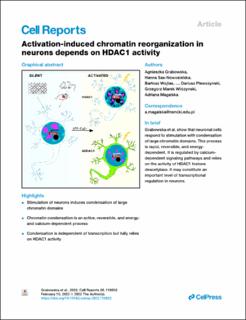Activation-induced chromatin reorganization in neurons depends on HDAC1 activity
Grabowska, Agnieszka; Sas-Nowosielska, Hanna; Wojtas, Bartosz; Holm-Kaczmarek, Dagmara; Januszewicz, Elzbieta; Yushkevich, Yana; Czaban, Iwona; Trzaskoma, Pawel; Krawczyk, Katarzyna; Gielniewski, Bartlomiej; Martin-Gonzalez, Ana; Filipkowski, Robert Kuba; Olszynski, Krzysztof Hubert; Bernas, Tytus; Szczepankiewicz, Andrzej Antoni; Sliwinska, Malgorzata Alicja; Kanhema, Tambudzai; Bramham, Clive Raymond Evjen; Bokota, Grzegorz; Plewczynski, Dariusz; Wilczynski, Grzegorz Marek; Magalska, Adriana
Journal article, Peer reviewed
Published version

Åpne
Permanent lenke
https://hdl.handle.net/11250/3057125Utgivelsesdato
2022Metadata
Vis full innførselSamlinger
- Department of Biomedicine [710]
- Registrations from Cristin [9791]
Sammendrag
Spatial chromatin organization is crucial for transcriptional regulation and might be particularly important in neurons since they dramatically change their transcriptome in response to external stimuli. We show that stimulation of neurons causes condensation of large chromatin domains. This phenomenon can be observed in vitro in cultured rat hippocampal neurons as well as in vivo in the amygdala and hippocampal neurons. Activity-induced chromatin condensation is an active, rapid, energy-dependent, and reversible process. It involves calcium-dependent pathways but is independent of active transcription. It is accompanied by the redistribution of posttranslational histone modifications and rearrangements in the spatial organization of chromosome territories. Moreover, it leads to the reorganization of nuclear speckles and active domains located in their proximity. Finally, we find that the histone deacetylase HDAC1 is the key regulator of this process. Our results suggest that HDAC1-dependent chromatin reorganization constitutes an important level of transcriptional regulation in neurons.
